

Compact Muon Solenoid
LHC, CERN
| CMS-SUS-16-040 ; CERN-EP-2017-312 | ||
| Search for $R$-parity violating supersymmetry in pp collisions at $\sqrt{s} = $ 13 TeV using b jets in a final state with a single lepton, many jets, and high sum of large-radius jet masses | ||
| CMS Collaboration | ||
| 24 December 2017 | ||
| Phys. Lett. B 783 (2018) 114 | ||
| Abstract: Results are reported from a search for physics beyond the standard model in proton-proton collisions at a center-of-mass energy of $\sqrt{s} = $ 13 TeV. The search uses a signature of a single lepton, large jet and bottom quark jet multiplicities, and high sum of large-radius jet masses, without any requirement on the missing transverse momentum in an event. The data sample corresponds to an integrated luminosity of 35.9 fb$^{-1}$ recorded by the CMS experiment at the LHC. No significant excess beyond the prediction from standard model processes is observed. The results are interpreted in terms of upper limits on the production cross section for $R$-parity violating supersymmetric extensions of the standard model using a benchmark model of gluino pair production, in which each gluino decays promptly via $ {\mathrm{\widetilde{g}}} \rightarrow \mathrm{t} \mathrm{b} \mathrm{s} $. Gluinos with a mass below 1610 GeV are excluded at 95% confidence level. | ||
| Links: e-print arXiv:1712.08920 [hep-ex] (PDF) ; CDS record ; inSPIRE record ; HepData record ; CADI line (restricted) ; | ||
| Figures & Tables | Summary | Additional Tables | References | CMS Publications |
|---|
|
Additional information on efficiencies needed for reinterpretation of
these results are available here
Additional technical material for CMS speakers can be found here |
| Figures | |

png pdf |
Figure 1:
Example diagram for the simplified model used as the benchmark signal in this analysis. |

png pdf |
Figure 2:
Distributions of $ {M_{\textrm {J}}} $, normalized to the same area, for $ {\mathrm {t}\overline {\mathrm {t}}} $ events and signal events with two different gluino masses in a selection of $ {H_{\mathrm {T}}} > $ 1200 GeV, $ {N_{\textrm {lep}}} = $ 1, $ {N_{\textrm {jet}}} \geq $ 8, $ {M_{\textrm {J}}} > $ 500 GeV, and $ {N_{\textrm {b}}} \geq $ 1. |

png pdf |
Figure 3:
Jet multiplicity distribution for data and MC simulation in a {$ {\mathrm {Z}} $+jets} control sample selected by requiring $ {N_{\textrm {lep}}} = $ 2, $ {H_{\mathrm {T}}} > $ 1200 GeV, $ {M_{\textrm {J}}} > $ 500 GeV, $ {N_{\textrm {b}}} = $ 1, and 80 $ < {m_{\ell \ell}} < $ 100 GeV. The total yield from simulation is normalized to the number of events in data. The uncertainty in the ratio of data to simulation yields (lower panel) is statistical only. |
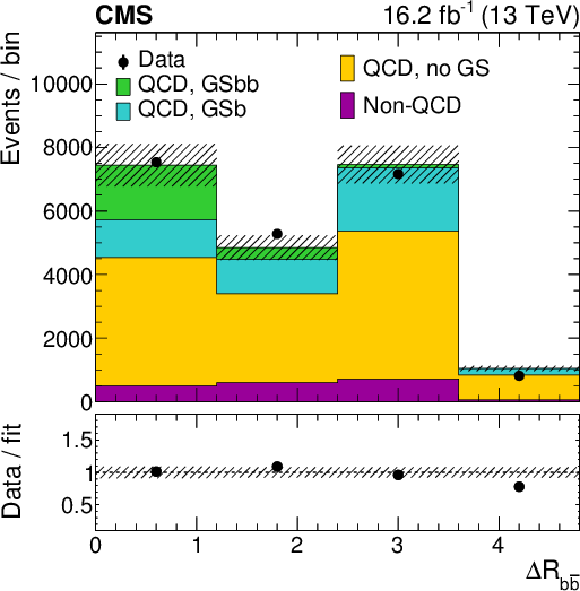
png pdf |
Figure 4:
Post-fit $\Delta R_{{{\mathrm {b}} {\overline {\mathrm {b}}}}}$ distributions in a selection with $ {N_{\textrm {lep}}} = 0$, $ {H_{\mathrm {T}}} > $ 1500 GeV, $ {N_{\textrm {b}}} = 2$, $ {N_{\textrm {jet}}} \geq 4$, and $ {M_{\textrm {J}}} > $ 500 GeV with the post-fit uncertainty represented by a hatched band. The ratio of data to simulation yields is shown in the lower panel. |
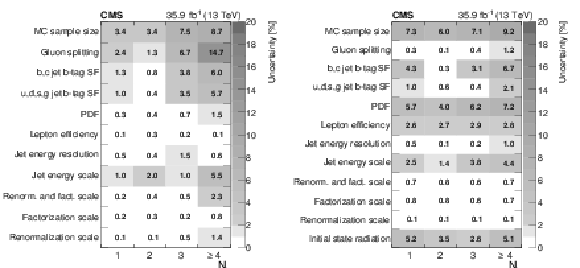
png pdf |
Figure 5:
Background (left) and $m_{\tilde{g}} = $ 1600 GeV signal (right) systematic uncertainties affecting the $ {N_{\textrm {b}}} $ shape (in percent) in the $ {N_{\textrm {jet}}} \geq 8$ and $ {M_{\textrm {J}}} \geq 1000 GeV $ bin. The uncertainties for other bins are similar. |

png pdf |
Figure 5-a:
Background (left) and $m_{\tilde{g}} = $ 1600 GeV signal (right) systematic uncertainties affecting the $ {N_{\textrm {b}}} $ shape (in percent) in the $ {N_{\textrm {jet}}} \geq 8$ and $ {M_{\textrm {J}}} \geq 1000 GeV $ bin. The uncertainties for other bins are similar. |
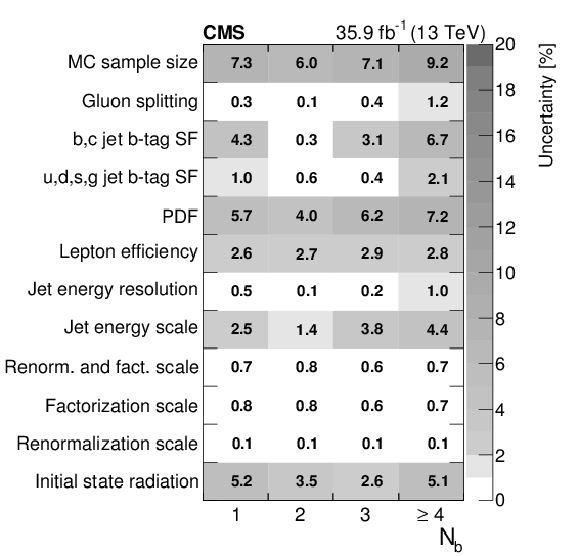
png pdf |
Figure 5-b:
Background (left) and $m_{\tilde{g}} = $ 1600 GeV signal (right) systematic uncertainties affecting the $ {N_{\textrm {b}}} $ shape (in percent) in the $ {N_{\textrm {jet}}} \geq 8$ and $ {M_{\textrm {J}}} \geq 1000 GeV $ bin. The uncertainties for other bins are similar. |
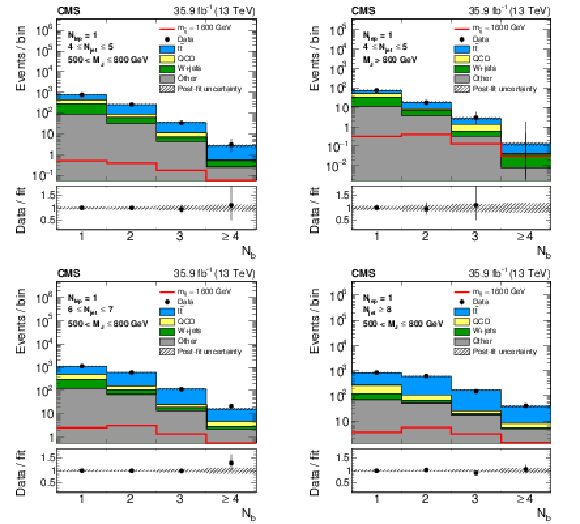
png pdf |
Figure 6:
Data and the background-only post-fit $ {N_{\textrm {b}}} $ distribution for bins with low expected signal contribution: 500 $ < {M_{\textrm {J}}} \leq $ 800 GeV, 4 $ \leq {N_{\textrm {jet}}} \leq $ 5 (upper-left), $ {M_{\textrm {J}}} > $ 800 GeV, 4 $ \leq {N_{\textrm {jet}}} \leq $ 5 (upper-right), 500 $ < {M_{\textrm {J}}} \leq $ 800 GeV, 6 $ \leq {N_{\textrm {jet}}} \leq $ 7 (lower-left), and 500 $ < {M_{\textrm {J}}} \leq $ 800 GeV, $ {N_{\textrm {jet}}} \geq $ 8 (lower-right). The expected signal distribution is also shown for a gluino mass of 1600 GeV. The ratio of data to post-fit yields is shown in the lower panel. The post-fit uncertainty is depicted as a hatched band. |

png pdf |
Figure 6-a:
Data and the background-only post-fit $ {N_{\textrm {b}}} $ distribution for bins with low expected signal contribution: 500 $ < {M_{\textrm {J}}} \leq $ 800 GeV, 4 $ \leq {N_{\textrm {jet}}} \leq $ 5 (upper-left), $ {M_{\textrm {J}}} > $ 800 GeV, 4 $ \leq {N_{\textrm {jet}}} \leq $ 5 (upper-right), 500 $ < {M_{\textrm {J}}} \leq $ 800 GeV, 6 $ \leq {N_{\textrm {jet}}} \leq $ 7 (lower-left), and 500 $ < {M_{\textrm {J}}} \leq $ 800 GeV, $ {N_{\textrm {jet}}} \geq $ 8 (lower-right). The expected signal distribution is also shown for a gluino mass of 1600 GeV. The ratio of data to post-fit yields is shown in the lower panel. The post-fit uncertainty is depicted as a hatched band. |

png pdf |
Figure 6-b:
Data and the background-only post-fit $ {N_{\textrm {b}}} $ distribution for bins with low expected signal contribution: 500 $ < {M_{\textrm {J}}} \leq $ 800 GeV, 4 $ \leq {N_{\textrm {jet}}} \leq $ 5 (upper-left), $ {M_{\textrm {J}}} > $ 800 GeV, 4 $ \leq {N_{\textrm {jet}}} \leq $ 5 (upper-right), 500 $ < {M_{\textrm {J}}} \leq $ 800 GeV, 6 $ \leq {N_{\textrm {jet}}} \leq $ 7 (lower-left), and 500 $ < {M_{\textrm {J}}} \leq $ 800 GeV, $ {N_{\textrm {jet}}} \geq $ 8 (lower-right). The expected signal distribution is also shown for a gluino mass of 1600 GeV. The ratio of data to post-fit yields is shown in the lower panel. The post-fit uncertainty is depicted as a hatched band. |

png pdf |
Figure 6-c:
Data and the background-only post-fit $ {N_{\textrm {b}}} $ distribution for bins with low expected signal contribution: 500 $ < {M_{\textrm {J}}} \leq $ 800 GeV, 4 $ \leq {N_{\textrm {jet}}} \leq $ 5 (upper-left), $ {M_{\textrm {J}}} > $ 800 GeV, 4 $ \leq {N_{\textrm {jet}}} \leq $ 5 (upper-right), 500 $ < {M_{\textrm {J}}} \leq $ 800 GeV, 6 $ \leq {N_{\textrm {jet}}} \leq $ 7 (lower-left), and 500 $ < {M_{\textrm {J}}} \leq $ 800 GeV, $ {N_{\textrm {jet}}} \geq $ 8 (lower-right). The expected signal distribution is also shown for a gluino mass of 1600 GeV. The ratio of data to post-fit yields is shown in the lower panel. The post-fit uncertainty is depicted as a hatched band. |
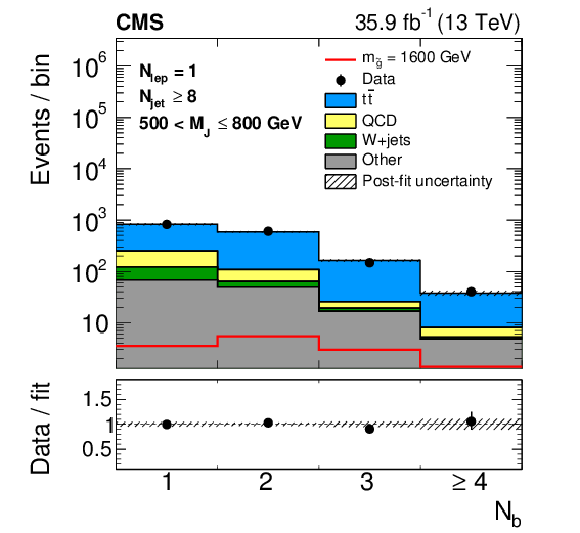
png pdf |
Figure 6-d:
Data and the background-only post-fit $ {N_{\textrm {b}}} $ distribution for bins with low expected signal contribution: 500 $ < {M_{\textrm {J}}} \leq $ 800 GeV, 4 $ \leq {N_{\textrm {jet}}} \leq $ 5 (upper-left), $ {M_{\textrm {J}}} > $ 800 GeV, 4 $ \leq {N_{\textrm {jet}}} \leq $ 5 (upper-right), 500 $ < {M_{\textrm {J}}} \leq $ 800 GeV, 6 $ \leq {N_{\textrm {jet}}} \leq $ 7 (lower-left), and 500 $ < {M_{\textrm {J}}} \leq $ 800 GeV, $ {N_{\textrm {jet}}} \geq $ 8 (lower-right). The expected signal distribution is also shown for a gluino mass of 1600 GeV. The ratio of data to post-fit yields is shown in the lower panel. The post-fit uncertainty is depicted as a hatched band. |

png pdf |
Figure 7:
Data and the background-only post-fit $ {N_{\textrm {b}}} $ distribution for bins with large expected signal contribution: 800 $ < {M_{\textrm {J}}} \leq 1000 GeV $, 6 $ \leq {N_{\textrm {jet}}} \leq $ 7 (upper-left), 800 $ < {M_{\textrm {J}}} \leq 1000 GeV $, $ {N_{\textrm {jet}}} \geq $ 8 (upper-right), $ {M_{\textrm {J}}} > $ 1000 GeV, 6 $ \leq {N_{\textrm {jet}}} \leq $ 7 (lower-left), and $ {M_{\textrm {J}}} > $ 1000 GeV, $ {N_{\textrm {jet}}} \geq $ 8 (lower-right). The expected signal distribution is also shown for a gluino mass of 1600 GeV. The ratio of data to post-fit yields is shown in the lower panel. The post-fit uncertainty is depicted as a hatched band. |
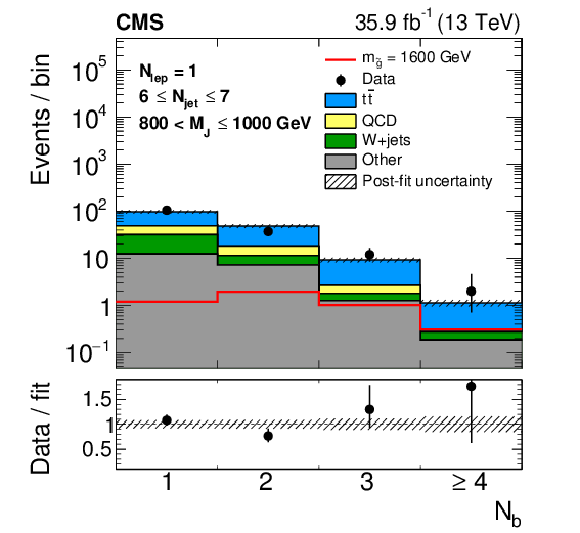
png pdf |
Figure 7-a:
Data and the background-only post-fit $ {N_{\textrm {b}}} $ distribution for bins with large expected signal contribution: 800 $ < {M_{\textrm {J}}} \leq 1000 GeV $, 6 $ \leq {N_{\textrm {jet}}} \leq $ 7 (upper-left), 800 $ < {M_{\textrm {J}}} \leq 1000 GeV $, $ {N_{\textrm {jet}}} \geq $ 8 (upper-right), $ {M_{\textrm {J}}} > $ 1000 GeV, 6 $ \leq {N_{\textrm {jet}}} \leq $ 7 (lower-left), and $ {M_{\textrm {J}}} > $ 1000 GeV, $ {N_{\textrm {jet}}} \geq $ 8 (lower-right). The expected signal distribution is also shown for a gluino mass of 1600 GeV. The ratio of data to post-fit yields is shown in the lower panel. The post-fit uncertainty is depicted as a hatched band. |

png pdf |
Figure 7-b:
Data and the background-only post-fit $ {N_{\textrm {b}}} $ distribution for bins with large expected signal contribution: 800 $ < {M_{\textrm {J}}} \leq 1000 GeV $, 6 $ \leq {N_{\textrm {jet}}} \leq $ 7 (upper-left), 800 $ < {M_{\textrm {J}}} \leq 1000 GeV $, $ {N_{\textrm {jet}}} \geq $ 8 (upper-right), $ {M_{\textrm {J}}} > $ 1000 GeV, 6 $ \leq {N_{\textrm {jet}}} \leq $ 7 (lower-left), and $ {M_{\textrm {J}}} > $ 1000 GeV, $ {N_{\textrm {jet}}} \geq $ 8 (lower-right). The expected signal distribution is also shown for a gluino mass of 1600 GeV. The ratio of data to post-fit yields is shown in the lower panel. The post-fit uncertainty is depicted as a hatched band. |
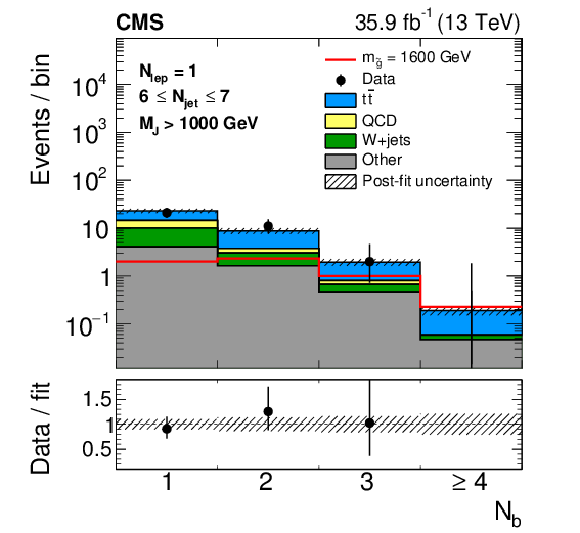
png pdf |
Figure 7-c:
Data and the background-only post-fit $ {N_{\textrm {b}}} $ distribution for bins with large expected signal contribution: 800 $ < {M_{\textrm {J}}} \leq 1000 GeV $, 6 $ \leq {N_{\textrm {jet}}} \leq $ 7 (upper-left), 800 $ < {M_{\textrm {J}}} \leq 1000 GeV $, $ {N_{\textrm {jet}}} \geq $ 8 (upper-right), $ {M_{\textrm {J}}} > $ 1000 GeV, 6 $ \leq {N_{\textrm {jet}}} \leq $ 7 (lower-left), and $ {M_{\textrm {J}}} > $ 1000 GeV, $ {N_{\textrm {jet}}} \geq $ 8 (lower-right). The expected signal distribution is also shown for a gluino mass of 1600 GeV. The ratio of data to post-fit yields is shown in the lower panel. The post-fit uncertainty is depicted as a hatched band. |
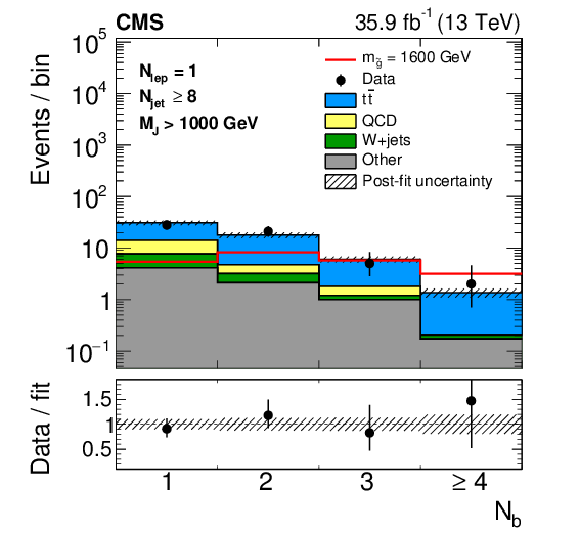
png pdf |
Figure 7-d:
Data and the background-only post-fit $ {N_{\textrm {b}}} $ distribution for bins with large expected signal contribution: 800 $ < {M_{\textrm {J}}} \leq 1000 GeV $, 6 $ \leq {N_{\textrm {jet}}} \leq $ 7 (upper-left), 800 $ < {M_{\textrm {J}}} \leq 1000 GeV $, $ {N_{\textrm {jet}}} \geq $ 8 (upper-right), $ {M_{\textrm {J}}} > $ 1000 GeV, 6 $ \leq {N_{\textrm {jet}}} \leq $ 7 (lower-left), and $ {M_{\textrm {J}}} > $ 1000 GeV, $ {N_{\textrm {jet}}} \geq $ 8 (lower-right). The expected signal distribution is also shown for a gluino mass of 1600 GeV. The ratio of data to post-fit yields is shown in the lower panel. The post-fit uncertainty is depicted as a hatched band. |
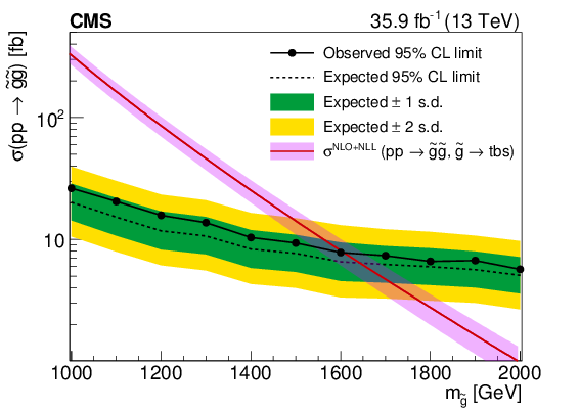
png pdf root |
Figure 8:
Cross section upper limits at 95% CL for a model of gluino pair production with $ \tilde{g}\rightarrow {\mathrm {t}} {\mathrm {b}} {\mathrm {s}}$ compared to the gluino pair production cross section. The theoretical uncertainties in the cross section are shown as a band around the red line\nobreakspace {} [66]. The expected limits (dashed line) and their ${\pm} $1 s.d. and ${\pm} $2 s.d. variations are shown as green and yellow bands, respectively. The observed limit is shown by the solid line with dots. |
| Tables | |
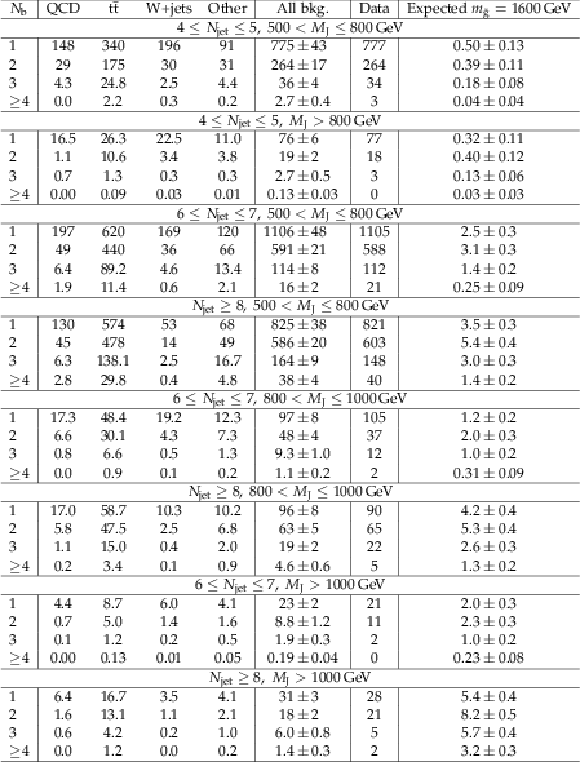
png pdf |
Table 1:
Post-fit yields for the background-only fit, observed data, and expected yields for $m_{\tilde{g}} = $ 1600 GeV in each search bin. |
| Summary |
| Results are presented from a search for new phenomena in events with a single lepton, large jet and bottom quark jet multiplicities, and high sum of large-radius jet masses, without a missing transverse momentum requirement. The background is predicted using a simultaneous fit in bins of the number of jets, number of b-tagged jets, and the sum of masses of large radius jets, using Monte Carlo simulated predictions with corrections measured in data control samples for the normalizations of the dominant backgrounds and nuisance parameters for theoretical and experimental uncertainties. Statistical uncertainties dominate in the signal regions, while the most important systematic uncertainties arise from the modeling of gluon splitting and the b quark tagging efficiency and mistag rate. The observed data are consistent with the background-only hypothesis. An upper limit of approximately 10 fb is determined for the gluino-gluino production cross section using a benchmark $R$-parity violating supersymmetry model of gluino pair production with a prompt three-body decay to tbs quarks, as predicted in minimal flavor violating models. For this model, gluinos are observed (expected) to be excluded up to 1610 (1640) GeV at a 95% confidence level, which improves upon previous searches at $\sqrt{s} = $ 8 TeV [26,27,28] and is comparable to recent results at 13 TeV [29]. |
| Additional Tables | |

png pdf |
Additional Table 1:
Cut flow table for backgrounds and the ${\mathrm{\tilde{g}}} \rightarrow \mathrm{t} \mathrm{ \bar{t} } \rightarrow \mathrm{t} \mathrm{b} \mathrm{s} $ model with $m_{{{\mathrm{\tilde{g}}}}} = $ 1600 GeV. Rows above the single horizontal line are part of the "baseline requirement''. The uncertainties due to MC sample size for "All bkg.'' are shown. |
| References | ||||
| 1 | R. Barbieri and G. F. Giudice | Upper bounds on supersymmetric particle masses | NPB 306 (1988) 63 | |
| 2 | G. Bertone, D. Hooper, and J. Silk | Particle dark matter: evidence, candidates and constraints | PR 405 (2005) 279 | hep-ph/0404175 |
| 3 | E. Witten | Dynamical breaking of supersymmetry | NPB 188 (1981) 513 | |
| 4 | S. Dimopoulos and H. Georgi | Softly broken supersymmetry and SU(5) | NPB 193 (1981) 150 | |
| 5 | P. Ramond | Dual theory for free fermions | PRD 3 (1971) 2415 | |
| 6 | \relax Yu. A. Golfand and E. P. Likhtman | Extension of the algebra of Poincar$ \'e $ group generators and violation of P invariance | JEPTL 13 (1971)323 | |
| 7 | A. Neveu and J. H. Schwarz | Factorizable dual model of pions | NPB 31 (1971) 86 | |
| 8 | D. V. Volkov and V. P. Akulov | Possible universal neutrino interaction | JEPTL 16 (1972)438 | |
| 9 | J. Wess and B. Zumino | A lagrangian model invariant under supergauge transformations | PLB 49 (1974) 52 | |
| 10 | J. Wess and B. Zumino | Supergauge transformations in four dimensions | NPB 70 (1974) 39 | |
| 11 | P. Fayet | Supergauge invariant extension of the Higgs mechanism and a model for the electron and its neutrino | NPB 90 (1975) 104 | |
| 12 | H. P. Nilles | Supersymmetry, supergravity and particle physics | Phys. Rep. 110 (1984) 1 | |
| 13 | G. R. Farrar and P. Fayet | Phenomenology of the production, decay, and detection of new hadronic states associated with supersymmetry | PLB 76 (1978) 575 | |
| 14 | ATLAS Collaboration | Search for top squarks in final states with one isolated lepton, jets, and missing transverse momentum in $ \sqrt{s} = $ 13 TeV pp collisions with the ATLAS detector | PRD 94 (2016) 052009 | 1606.03903 |
| 15 | CMS Collaboration | Search for top squark pair production in pp collisions at $ \sqrt{s} = $ 13 TeV using single lepton events | JHEP 10 (2017) 013 | CMS-SUS-16-051 1706.04402 |
| 16 | ATLAS Collaboration | Search for gluinos in events with an isolated lepton, jets and missing transverse momentum at $ \sqrt{s} = $ 13 TeV with the ATLAS detector | EPJC 76 (2016) 565 | 1605.04285 |
| 17 | ATLAS Collaboration | Search for squarks and gluinos in final states with jets and missing transverse momentum at $ \sqrt{s} = $ 13 TeV with the ATLAS detector | EPJC 76 (2016) 392 | 1605.03814 |
| 18 | ATLAS Collaboration | Search for new phenomena in final states with large jet multiplicities and missing transverse momentum with ATLAS using $ \sqrt{s} = $ 13 TeV proton-proton collisions | PLB 757 (2016) 334 | 1602.06194 |
| 19 | CMS Collaboration | Search for new phenomena with the $ M_{\text{T2}} $ variable in the all-hadronic final state produced in proton-proton collisions at $ \sqrt{s} = $ 13 TeV | CMS-SUS-16-036 1705.04650 |
|
| 20 | CMS Collaboration | Search for supersymmetry in multijet events with missing transverse momentum in proton-proton collisions at 13 TeV | PRD 96 (2017) 032003 | CMS-SUS-16-033 1704.07781 |
| 21 | CMS Collaboration | Search for supersymmetry in pp collisions at $ \sqrt{s} = $ 13 TeV in the single-lepton final state using the sum of masses of large-radius jets | PRL 119 (2017) 151802 | CMS-SUS-16-037 1705.04673 |
| 22 | C. Cs\'aki, Y. Grossman, and B. Heidenreich | MFV SUSY: a natural theory for $ R $-parity violation | PRD 85 (2012) 095009 | 1111.1239 |
| 23 | R. Barbier et al. | $ R $-parity violating supersymmetry | PR 420 (2005) 1 | hep-ph/0406039 |
| 24 | J. Alwall, P. Schuster, and N. Toro | Simplified models for a first characterization of new physics at the LHC | PRD 79 (2009) 075020 | 0810.3921 |
| 25 | LHC New Physics Working Group, D. Alves et al. | Simplified models for LHC new physics searches | JPG 39 (2012) 105005 | 1105.2838 |
| 26 | ATLAS Collaboration | A search for top squarks with $ R $-parity-violating decays to all-hadronic final states with the ATLAS detector in $ \sqrt{s} = $ 8 TeV proton-proton collisions | JHEP 06 (2016) 067 | 1601.07453 |
| 27 | CMS Collaboration | Searches for $ R $-parity-violating supersymmetry in pp collisions at $ \sqrt{s} = $ 8 TeV in final states with 0-4 leptons | PRD 94 (2016) 112009 | CMS-SUS-14-003 1606.08076 |
| 28 | CMS Collaboration | Search for $ R $-parity violating supersymmetry with displaced vertices in proton-proton collisions at $ \sqrt{s} = $ 8 TeV | PRD 95 (2017) 012009 | CMS-SUS-14-020 1610.05133 |
| 29 | ATLAS Collaboration | Search for new phenomena in a lepton plus high jet multiplicity final state with the ATLAS experiment using $ \sqrt{s} = $ 13 TeV proton-proton collision data | JHEP 09 (2017) 088 | 1704.08493 |
| 30 | A. Hook, E. Izaguirre, M. Lisanti, and J. G. Wacker | High multiplicity searches at the LHC using jet masses | PRD 85 (2012) 055029 | 1202.0558 |
| 31 | T. Cohen, E. Izaguirre, M. Lisanti, and H. K. Lou | Jet substructure by accident | JHEP 03 (2013) 161 | 1212.1456 |
| 32 | S. El Hedri, A. Hook, M. Jankowiak, and J. G. Wacker | Learning how to count: a high multiplicity search for the LHC | JHEP 08 (2013) 136 | 1302.1870 |
| 33 | ATLAS Collaboration | Search for massive supersymmetric particles decaying to many jets using the ATLAS detector in pp collisions at $ \sqrt{s} = $ 8 TeV | PRD 91 (2015) 112016 | 1502.05686 |
| 34 | ATLAS Collaboration | Search for new phenomena in final states with large jet multiplicities and missing transverse momentum at $ \sqrt{s} = $ 8 TeV proton-proton collisions using the ATLAS experiment | JHEP 10 (2013) 130 | 1308.1841 |
| 35 | CMS Collaboration | Search for supersymmetry in pp collisions at $ \sqrt{s} = $ 13 TeV in the single-lepton final state using the sum of masses of large-radius jets | JHEP 08 (2016) 122 | CMS-SUS-15-007 1605.04608 |
| 36 | CMS Collaboration | The CMS experiment at the CERN LHC | JINST 3 (2008) S08004 | CMS-00-001 |
| 37 | J. Alwall et al. | The automated computation of tree-level and next-to-leading order differential cross sections, and their matching to parton shower simulations | JHEP 07 (2014) 079 | 1405.0301 |
| 38 | J. Alwall et al. | Comparative study of various algorithms for the merging of parton showers and matrix elements in hadronic collisions | EPJC 53 (2008) 473 | 0706.2569 |
| 39 | P. Nason | A new method for combining NLO QCD with shower Monte Carlo algorithms | JHEP 11 (2004) 040 | hep-ph/0409146 |
| 40 | S. Frixione, P. Nason, and C. Oleari | Matching NLO QCD computations with parton shower simulations: the POWHEG method | JHEP 11 (2007) 070 | 0709.2092 |
| 41 | S. Alioli, P. Nason, C. Oleari, and E. Re | A general framework for implementing NLO calculations in shower Monte Carlo programs: the POWHEG BOX | JHEP 06 (2010) 043 | 1002.2581 |
| 42 | R. Frederix and S. Frixione | Merging meets matching in MC@NLO | JHEP 12 (2012) 061 | 1209.6215 |
| 43 | T. Sjostrand et al. | An introduction to PYTHIA 8.2 | CPC 191 (2015) 159 | |
| 44 | P. Skands, S. Carrazza, and J. Rojo | Tuning PYTHIA 8.1: the Monash 2013 tune | EPJC 74 (2014) 3024 | |
| 45 | GEANT4 Collaboration | GEANT4---a simulation toolkit | NIMA 506 (2003) 250 | |
| 46 | CMS Collaboration | Particle-flow reconstruction and global event description with the CMS detector | JINST 12 (2017) P10003 | CMS-PRF-14-001 1706.04965 |
| 47 | M. Cacciari, G. P. Salam, and G. Soyez | The anti-$ k_t $ jet clustering algorithm | JHEP 04 (2008) 063 | 0802.1189 |
| 48 | M. Cacciari, G. P. Salam, and G. Soyez | FastJet user manual | EPJC 72 (2012) 1896 | 1111.6097 |
| 49 | CMS Collaboration | Performance of electron reconstruction and selection with the CMS detector in proton-proton collisions at $ \sqrt{s} = $ 8 TeV | JINST 10 (2015) P06005 | CMS-EGM-13-001 1502.02701 |
| 50 | CMS Collaboration | Performance of CMS muon reconstruction in pp collision events at $ \sqrt{s} = $ 7 TeV | JINST 7 (2012) P10002 | CMS-MUO-10-004 1206.4071 |
| 51 | K. Rehermann and B. Tweedie | Efficient identification of boosted semileptonic top quarks at the LHC | JHEP 03 (2011) 059 | 1007.2221 |
| 52 | M. Cacciari and G. P. Salam | Pileup subtraction using jet areas | PLB 659 (2008) 119 | 0707.1378 |
| 53 | CMS Collaboration | Determination of jet energy calibration and transverse momentum resolution in CMS | JINST 6 (2011) P11002 | CMS-JME-10-011 1107.4277 |
| 54 | CMS Collaboration | Identification of b-quark jets with the CMS experiment | JINST 8 (2013) P04013 | CMS-BTV-12-001 1211.4462 |
| 55 | CMS Collaboration | Identification of heavy-flavour jets with the CMS detector in pp collisions at 13 TeV | Submitted to JINST | CMS-BTV-16-002 1712.07158 |
| 56 | ATLAS Collaboration | Search for direct pair production of the top squark in all-hadronic final states in proton-proton collisions at $ \sqrt{s} = $ 8 TeV with the ATLAS detector | JHEP 09 (2014) 015 | 1406.1122 |
| 57 | CMS Collaboration | The CMS trigger system | JINST 12 (2017) P01020 | CMS-TRG-12-001 1609.02366 |
| 58 | CMS Collaboration | Performance of heavy flavour identification algorithms in proton-proton collisions at 13 TeV at the CMS experiment | CDS | |
| 59 | CMS Collaboration | Jet energy scale and resolution in the CMS experiment in pp collisions at 8 TeV | JINST 12 (2017), no. 02, P02014 | CMS-JME-13-004 1607.03663 |
| 60 | CMS Collaboration | CMS luminosity measurements for the 2016 data taking period | CMS-PAS-LUM-17-001 | CMS-PAS-LUM-17-001 |
| 61 | NNPDF Collaboration | Parton distributions for the LHC Run II | JHEP 04 (2015) 040 | 1410.8849 |
| 62 | A. L. Read | Presentation of search results: the $ \rm CL_s $ technique | JPG 28 (2002) 2693 | |
| 63 | ATLAS and CMS Collaborations, LHC Higgs Combination Group | Procedure for the LHC Higgs boson search combination in Summer 2011 | CMS-NOTE-2011-005 | |
| 64 | G. Cowan, K. Cranmer, E. Gross, and O. Vitells | Asymptotic formulae for likelihood-based tests of new physics | EPJC 71 (2011) 1554, . [Erratum: \DOI10.1140/epjc/s10052-013-2501-z] | |
| 65 | T. Junk | Confidence level computation for combining searches with small statistics | NIMA 434 (1999) 435 | hep-ex/9902006 |
| 66 | C. Borschensky et al. | Squark and gluino production cross sections in pp collisions at $ \sqrt{s}= $ 13, 14, 33, and 100 TeV | EPJC 74 (2014) 3174 | 1407.5066 |

|
Compact Muon Solenoid LHC, CERN |

|

|

|

|

|

|